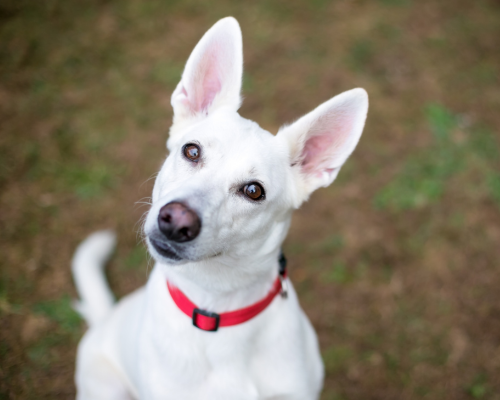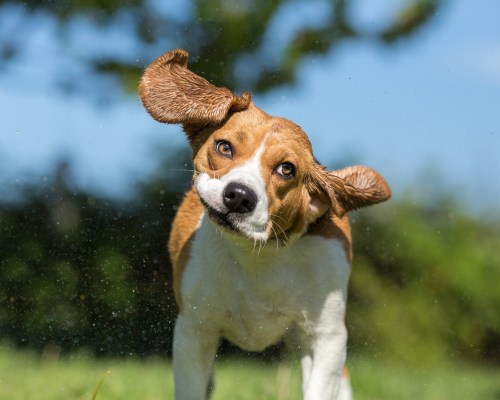A Bump on Top of My Dog's Head? Cause!
A Bump on Top of My Dog's Head? Cause!

Vet Reviewed

By: Sarah Hodgson
July 10, 2023
- Posted in Dogs
Table of Contents
Have you ever petted your dog on its head and felt something? But what could it be? "What's that bump on top of my dog's head?" In this article, we'll explore what this bump is, its function, which breeds typically have it, and any potential health issues connected to it. Let's dive in!
What Is An Occiput? (The Bump)
The bump that you notice on top of your dog's head is called an occiput (remember the term as it'll be mentioned a lot). The occiput, also referred to in its fancier term as "external occipital protuberance", is a natural part of a dog's skull. In some dogs, this bump is more prominent and easily noticeable, while in others, it may be more subtle. The occiput is not unique to dogs - humans have it too! It's found at the base of the skull, just above the back of the neck. In dogs, however, the occiput is typically larger and more pronounced, making it a notable feature.
So not to panic! That's just your dog's skull.
What's The Function of a Dog's Occiput?
The occiput plays a crucial role in a dog's anatomy and movement. It's where some of the major muscles in a dog's neck and back connect to the skull. These muscles are responsible for supporting the head and allowing it to move smoothly with its spine.
Muscle Attachment and Movement Support
The occiput serves as a point of attachment for major muscles in a dog's neck and back. These muscles, such as the nuchal ligament and trapezius muscle, help support the head and enable smooth movement.
Shock Absorption and Brain Protection
As a natural part of the skull, the occiput acts as a protective feature for the dog's brain. In the event of a head impact or fall, the occiput helps distribute the force and minimize potential injury to the brain, acting as a shock absorber.
Stabilization of Head Position
The occiput aids in stabilizing the position of the dog's head. It contributes to the overall balance and coordination of movements, allowing the dog to maintain steady control over its head position.
Dog Breeds With Bumpy Heads (Occiputs)
While all dogs have an occiput, it is more noticeable in certain breeds. Dog breeds with bumpy heads or pronounced occiputs often include hounds, like Bloodhounds and Basset Hounds. Breeds like the Golden Retriever, Labrador Retriever, and German Shepherds also tend to have a noticeable occiput.
On the other hand, breeds with flatter heads, like Bulldogs or Boxers, may have a less pronounced occiput. Regardless of the breed, a prominent occiput is completely normal and not a cause for concern.
Here's a list of dog breeds with a more pronounced occiput and some less well-known or less popular breeds with a less pronounced occiput:
Breeds with a more pronounced occiput:
- Bloodhound
- Basset Hound
- Rottweiler
- Golden Retriever
- Labrador Retriever
- German Shepherd
- Doberman Pinscher
- Afghan Hound
- Saint Bernard
- Boxer
Breeds with a less pronounced occiput (less popular breeds):
- Norwegian Lundehund
- Azawakh
- Cirneco dell'Etna
- Finnish Lapphund
- Lagotto Romagnolo
- Xoloitzcuintli
- Tibetan Spaniel
- Affenpinscher
- Harrier
- Dandie Dinmont Terrier
Please note that the prominence of the occiput can vary even within breeds, so this list represents general trends but may not be absolute for every individual dog.

Occiput Issues to Look Out For
While the occiput is a natural part of a dog's anatomy, it's important to keep an eye out for any changes or issues. If your dog's occiput seems to be swelling or growing rapidly, or if it's causing your dog discomfort, it's a good idea to consult with a veterinarian. Other potential issues could include redness, heat, or tenderness around the occiput. These symptoms could indicate an infection or other underlying health problem. Always remember, when in doubt, it's better to seek a vet's advice and be on the safe side.
Can a Dog’s Occiput Get Bigger?
A puppy's occiput can grow as they mature into adulthood. However, in a fully-grown dog, the occiput should remain roughly the same size. If you notice your adult dog's occiput getting bigger, it could be a sign of a health issue such as a bone disorder, tumor, or inflammation, and should be checked by a veterinarian.
Can It Affect A Dogs Health?
In most cases, a prominent occiput does not affect a dog's health. However, as mentioned before, if the occiput appears to be growing or causing discomfort, it could signal an underlying health issue that needs to be addressed. The occiput itself doesn't cause health problems, but changes to it can be a symptom of a broader issue. So, while the occiput is generally not a concern, changes to its size, shape, or the discomfort it causes should always be taken seriously.
The Bottom Line
To sum up, the small bump on top of your dog's head is called the occiput, and it is a natural part of their anatomy. The occiput serves important functions in a dog's movement, as it connects major muscles in the neck and back to the skull, providing support and allowing for smooth head movement.
That bump can't be changed or altered as we like to call it the "smart bump"

Subscribe to Petfluence!
Get updates on the latest posts and more from Petfluence straight to your inbox.